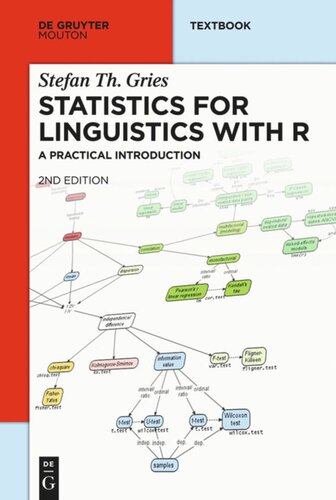

Most ebook files are in PDF format, so you can easily read them using various software such as Foxit Reader or directly on the Google Chrome browser.
Some ebook files are released by publishers in other formats such as .awz, .mobi, .epub, .fb2, etc. You may need to install specific software to read these formats on mobile/PC, such as Calibre.
Please read the tutorial at this link: https://ebookbell.com/faq
We offer FREE conversion to the popular formats you request; however, this may take some time. Therefore, right after payment, please email us, and we will try to provide the service as quickly as possible.
For some exceptional file formats or broken links (if any), please refrain from opening any disputes. Instead, email us first, and we will try to assist within a maximum of 6 hours.
EbookBell Team

4.8
14 reviewsThis book is the revised and extended second edition of Statistics for Linguistics with R. The volume is an introduction to statistics for linguists using the open source software R. It is aimed at students and instructors/professors with little or no statistical background and is written in a non-technical and reader-friendly/accessible style.
It first introduces in detail the overall logic underlying quantitative studies: exploration, hypothesis formulation and operationalization, and the notion and meaning of significance tests. It then introduces some basics of the software R relevant to statistical data analysis. A chapter on descriptive statistics explains how summary statistics for frequencies, averages, and correlations are generated with R and how they are graphically represented best. A chapter on analytical statistics explains how statistical tests are performed in R on the basis of many different linguistic case studies: For nearly every single example, it is explained what the structure of the test looks like, how hypotheses are formulated, explored, and tested for statistical significance, how the results are graphically represented, and how one would summarize them in a paper/article. A chapter on selected multifactorial methods introduces how more complex research designs can be studied: methods for the study of multifactorial frequency data, correlations, tests for means, and binary response data are discussed and exemplified step-by-step. Also, the exploratory approach of hierarchical cluster analysis is illustrated in detail.
The book comes with many exercises, boxes with short think breaks and warnings, recommendations for further study, and answer keys as well as a statistics for linguists newsgroup on the companion website.
Just like the first edition, it is aimed at students, faculty, and researchers with little or no statistical background in statistics or the open source programming language R. It avoids mathematical jargon and discusses the logic and structure of quantitative studies and introduces descriptive statistics as well as a range of monofactorial statistical tests for frequencies, distributions, means, dispersions, and correlations. The comprehensive revision includes new small sections on programming topics that facilitate statistical analysis, the addition of a variety of statistical functions readers can apply to their own data, a revision of overview sections on statistical tests and regression modeling, a complete rewrite of the chapter on multifactorial approaches, which now contains sections on linear regression, binary and ordinal logistic regression, multinomial and Poisson regression, and repeated-measures ANOVA, and a new visual tool to identify the right statistical test for a given problem and data set. The amount of code available from the companion website has doubled in size, providing much supplementary material on statistical tests and advanced plotting.